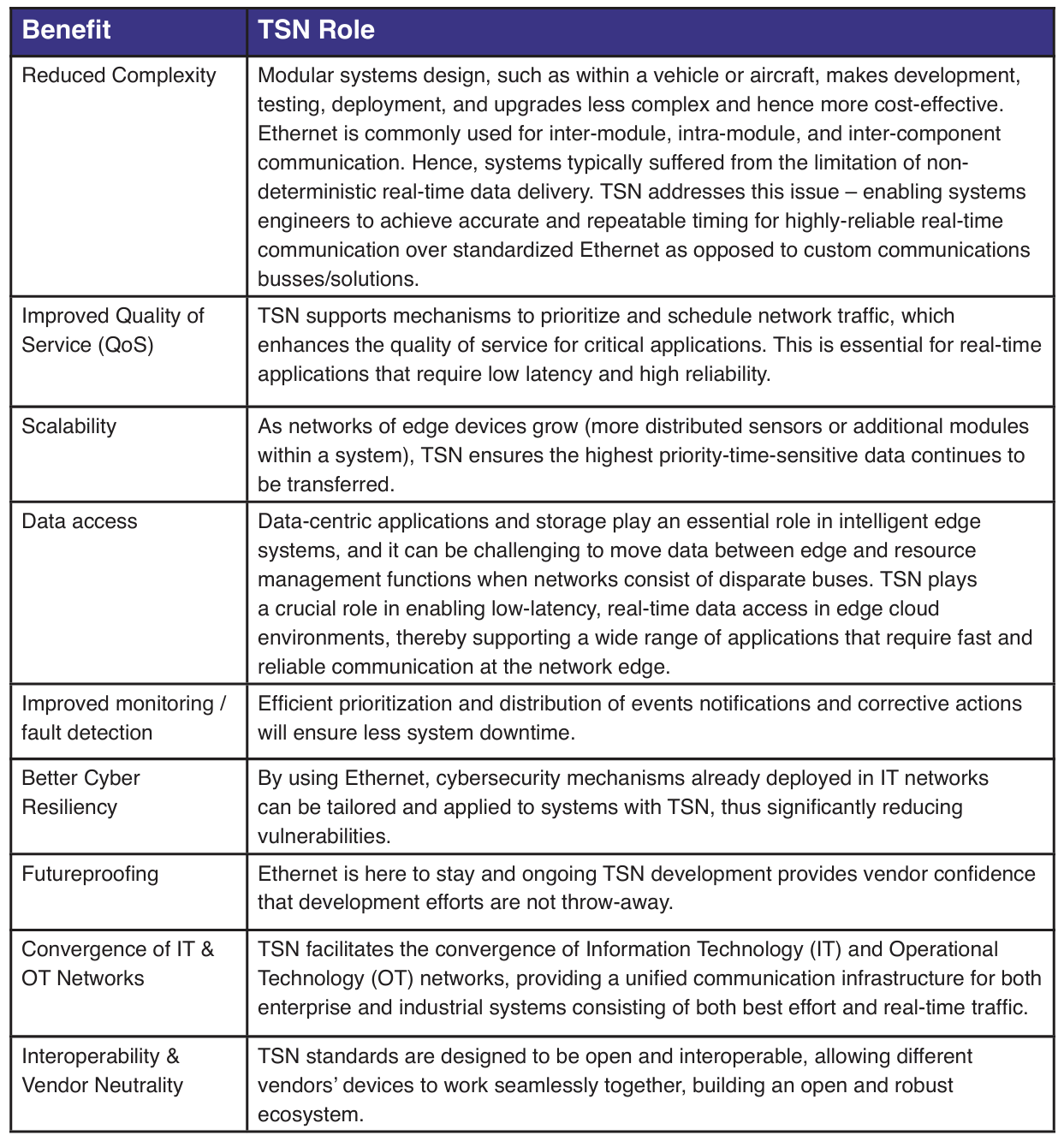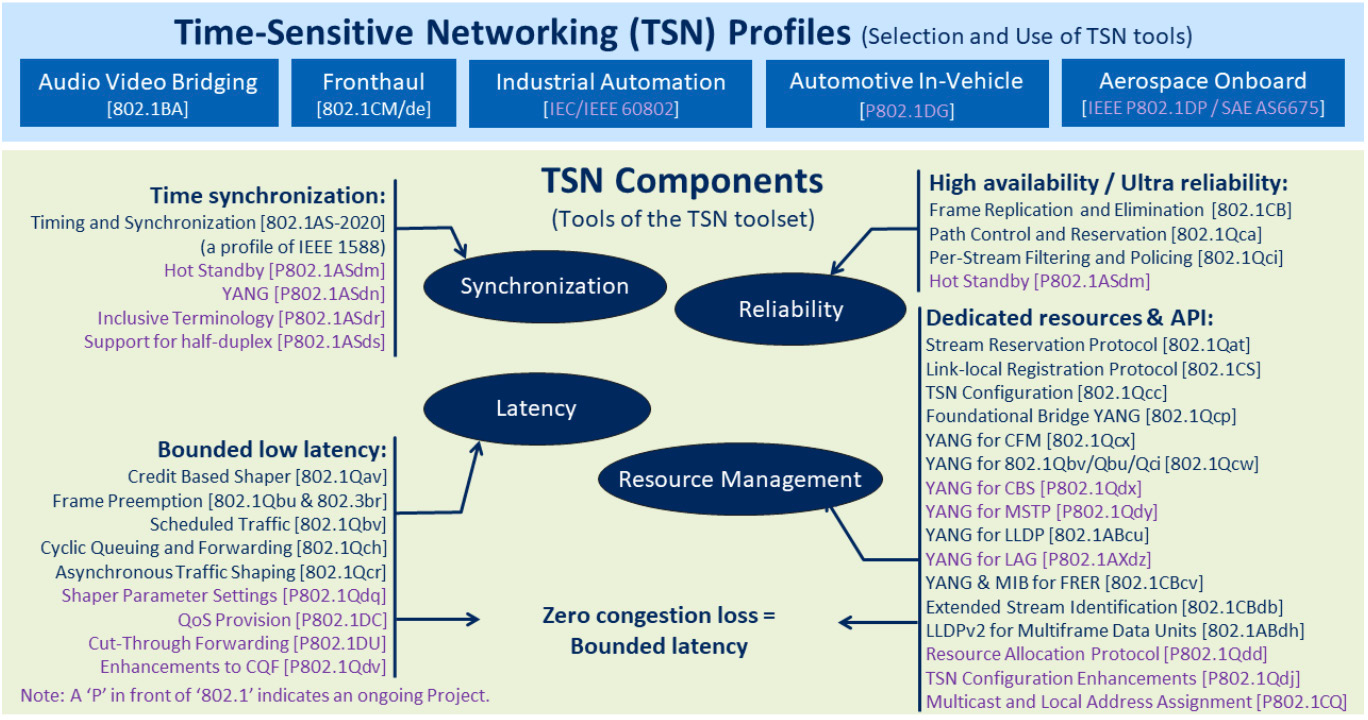Hitting the Moving Target with Time-Sensitive Networking
An Industry Collaboration on Risk Mitigation
Introduction
Mission-critical systems increasingly rely on Ethernet connectivity between modules or devices. Traditional Ethernet (IEEE 802.3 and 802.1Q) has no concept of time regarding data delivery, and thus it is not possible to ensure all real-time data arrives at its destination on time – especially as data loads increase. Deterministic system behavior thus cannot be achieved.
Time-Sensitive Networking (TSN) addresses this problem, guaranteeing minimal network latency and jitter, and provides for bounded end-to-end delay and guaranteed message delivery time. TSN also allows for the transmission of time-sensitive and non-time-sensitive data on the same network. Sitting mostly at layer 2 (the Data Link Layer) of the Open Systems Interconnection (OSI) model, IEEE802.1 and IEEE802.1Q-2022 (optional) TSN features enable deterministic networking over general purpose Ethernet. However, definition of the relevant specifications is on-going, with some defined and included in the main IEEE 802.1Q-2022 specification and some like cut-through (P802.1DU) in progress - all tackling different issues and functionality.
Hence, this poses a problem for Internet of Things (IoT) edge device vendors as to which specifications are relevant to their products. Additionally, this can induce a lack of confidence that their products are future-proof.
In this paper we will outline some of the on-going work on TSN. More crucially, we will discuss how this ‘moving target’ can be addressed, by a ‘back-to-basics’ approach. We recommend organizations have a baseline TSN offering, involving established aspects of IEEE 802.1, to create successful mission-critical systems today and to be future-proof tomorrow.
Making a Difference with TSN
In this section, we review the numerous benefits that TSN can provide across a range of edge and industrial applications.
NOTE: There are also complexities driven by TSN and other scheduled solutions. However, these complexities are not the topic of this paper.

IEEE 802.1 TSN Recap
Time-Sensitive Networking (TSN) has become the collective term for a technology aiming to deliver deterministic network connectivity with bounded latency for many applications. The TSN task group of the IEEE 802.1 working group has been operating since 2012 to define the relevant IEEE standards and is still highly active. The task group divides the TSN protocol suite into four categories of sub-protocols.

Clock Synchronization
It is evident clock synchronization is an essential feature in any TSN solution and a prerequisite for time-aware traffic scheduling (covered below), although some basic TSN use cases can be defined without it. The required synchronization accuracy can be achieved with the Precision Time Protocol (PTP) (IEEE 1588-20191). Industry profiles generally refer to IEEE 802.1AS-20202, which specifies the profile for use of 1588-2019 in TSN, as the preferred standard, adding several enhancements for time redundancy compared to the previous revision, making it the primary choice. It is also specified in all the industry profiles (later).
The key aspects of TSN clock synchronization using PTP are:
- Grandmaster Clock: In a TSN network, one device is designated as the Grandmaster Clock. This device typically has a highly accurate clock source and serves as the reference for time synchronization.
- Best Time Transmitter Clock Algorithm (BTCA): In a PTP network, the Best Time Transmitter Clock Algorithm is used to select the best clock source as the Grandmaster Clock. This ensures that the entire network is synchronized to a common time reference.
- PTP Messages: Devices in the network exchange PTP messages to determine the offset between their clocks and the Grandmaster Clock.
- Clock Adjustment: Based on the information gathered from PTP messages, each device adjusts its clock to align with the network reference time provided by the Grandmaster Clock. This adjustment is done in a way that minimizes the time offset and compensates for network delays.
NOTE: Clock synchronization is a complex topic and platform specific implementation details may vary based on the specific applications and use cases.
Latency - Data Scheduling and Traffic Shaping
Traffic shaping guarantees bounded low latency in TSN applications. There are several specifications to consider but the most important is IEEE 802.1Qbv3 (Enhancements for Scheduled Traffic). This defines the Time-Aware Shaper (TAS) which enables isochronous communication between devices.
Another important standard is IEEE 802.1Qav4 (Forwarding and Queuing Enhancements for Time-Sensitive Streams, FQTSS in IEEE 802.1Q-2022). This defines the credit-based shaper (CBS) which limits bandwidth for certain traffic – for simpler asynchronous end devices which do not support time synchronization.
Frame preemption, specified by IEEE 802.1Qbu5 and IEEE 802.3br (Interspersed Express Traffic, IET in the main specifications) is another important feature in a TSN portfolio. As TSN allows for mixing real-time traffic with best-effort traffic on the same network, real-time traffic may be delayed for the full transmission time of one maximum sized Ethernet frame. 802.1Qbu mitigates this by allowing express traffic to interrupt transmission of lower priority traffic and thus reducing worst case latency. Automotive and Industrial profiles specify the use of 802.1Qbu.
NOTE: 802.1Qbv, 802.1Qav and 802.1Qbu have all been rolled into the base Ethernet standard for bridges and bridged networks since 2018 with the latest revision being IEEE 802.1Q-20226 which further confirms their maturity.
Reliability
The ability to provide reliable communication is crucial in modern networks, where the loss of communication can be fatal for some applications. For this reason, it is particularly important to provide multiple forms of redundancy. As mentioned above, 802.1AS provides for time synchronization redundancy. Furthermore, 802.1CB7 (Frame Replication and Elimination for Reliability, FRER) provides the specification for end-to-end redundant communication. By replicating communication over multiple paths, resilience to hardware failures can be achieved.
Also important is 802.1Qci8 (Per Stream Filtering and Policing) for frame counting, f iltering, policing, and service class selection for a frame based on the data stream to which the frame belongs. Policing and filtering functions include the detection and mitigation of disruptive transmissions by other systems in a network, improving the robustness of that network.
NOTE: The use of the 802.1CB alone is not enough to ensure high reliability. System developers should also consider physical redundancy and separation of the Ethernet fabric to achieve the required level of reliability.
Resource Management
Each real-time application has specific requirements on network performance, hence configuring and managing network resources is essential. Again, this is achieved by adhering to standards-based mechanisms as follows:
- IEEE 802.1Qat9 – Flow reservation
- IEEE 802.1Qcc10 – Configuration
- YANG data models for TSN configuration – IEEE802.1ASdn (Time synchronization), IEEE 802.1Qcw (Scheduled traffic), IEEE 802.1Qdx (Credit- based shaper), and IEEE 802.1CBcv (FRER).
Industry Verticals and TSN Profiles
As TSN technology providers, companies must select which TSN specifications are relevant to implement in their products. This can be a challenging task especially for a technology that is still evolving. To aid in this effort, organizations within specific industry verticals have formed additional projects within IEEE 802 to define special TSN profiles applicable to their respective markets. Conformance to one or more profiles helps ensure interoperability with vendors in the specific market
IEEE P802.1DP - TSN for Aerospace Onboard Ethernet Communications11
This standard specifies profiles of IEEE 802.1 Time-Sensitive Networking (TSN) and IEEE 802.1 Security standards for aerospace onboard bridged Ethernet networks. The profiles select features, options, configurations, defaults, protocols, and procedures of bridges, end stations, and Local Area Networks to build deterministic networks for aerospace onboard communications. This standard specifies profiles for designers, implementers, integrators, and certification agencies of deterministic IEEE 802.3 Ethernet networks that support a broad range of aerospace onboard applications including those requiring security, high availability and reliability, maintainability, and bounded latency.
IEEE P802.1DG - TSN for Automotive In-Vehicle Ethernet Communications12
This standard specifies profiles for secure, highly reliable, deterministic latency, automotive in-vehicle bridged IEEE 802.3 Ethernet networks based on IEEE 802.1 Time-Sensitive Networking (TSN) standards and IEEE 802.1 Security standards. This standard provides profiles for designers and implementers of deterministic IEEE 802.3 Ethernet networks that support the entire range of in-vehicle applications including those requiring security, high availability and reliability, maintainability, and bounded latency.
IEEE 60802 - TSN for Industrial Automation13
This is a joint project of IEC SC65C/WG18 and IEEE 802 to define TSN profiles for industrial automation. This joint work will provide a jointly developed standard that is both an IEC and an IEEE standard, i.e., a dual logo standard. This standard defines time-sensitive networking profiles for industrial automation. The profiles select features, options, configurations, defaults, protocols, and procedures of bridges, end stations, and LANs to build industrial automation networks.
All three of the above profiles utilize the Time Awareness Shaper, (in the Data Scheduling and Traffic Shaping sub-protocol category) for enabling isochronous communication between devices. They also use the Credit Based Shaper aspects for simpler asynchronous end devices which do not support time synchronization.
Companies that offer technology solutions to multiple markets must consider multiple profiles in their TSN offering. Even though the profiles are still under development, these standards already provide useful guidance to implementors. Conformance to the profiles guarantees implementors can build products that interoperate with other vendors in their specific market.
Recommending Back to Basics
As we have seen, TSN is a highly active area, with standards defined, evolving, or planned; interoperability tested via plugfest activities; and establishment of industry profiles attempting to address specific use cases and scenarios.
For an equipment vendor, this ‘moving target’ can be daunting and may impede their decision to adopt TSN into their technologies and products. To help allay concern, three key factors should be taken into consideration:
- Avoid over-indexing on supporting all standards and focus on supporting a solid baseline with well-designed software, for a mission-critical, safety-certified environment.
- Understand and highlight hardware dependencies to meet the requirements of the standard.
- Use a basic set of standards as recommended below.
The baseline set of standards needed for futureproof implementation
A future-proof solution for TSN will need to support the following:
- Clock Synchronization: 802.1AS-2020 — to ensure time is precisely the same for all components of the system.
- Data Scheduling and Traffic Shaping: 802.1Qav, 802.1Qbv, and 802.1Qbu — to drive deterministic traffic timing.
Additionally, for mission-critical systems requiring higher reliability, the solution needs to support:
- Reliability: 802.1CB — to ensure resilience of the system.
Conclusion
The success of TSN depends on interoperability and performance. In this document, the undersigned organizations have come together to affirm that the standards referenced herein are immutable components of TSN and form the foundation of our products and offerings in our respective markets.
To date, some 20 standards have been completed and another 10 are in draft status14.
Vendors and implementers will continue to collaborate to refine the set of standards that comprise Time-Sensitive Networking. Results from real world implementations may influence the standards’ refinement, but the standards discussed here form the foundation for confident product development.
A TSN portfolio should at least include the above-mentioned standards to provide a solid foundation for building future-proof TSN-capable products.
A Collective View
This positioning paper reflects the joint position of the following organizations and their representatives.

Craig Turner, Senior Director - DevSecOps ASUX, Aptiv PLC
Craig has more than 20 years of experience across the automotive, mobile, and gaming industries with a focus on delivering embedded products and software services. Craig joined Aptiv in 2020 as UX Global Engineering Director before transitioning over to Senior Director, Head of Aptiv Services. Prior to joining Aptiv, Craig worked at Harman International, Symphony Teleca, and Nokia in product management, engineering, and software architect roles.

David Zage, Time Architecture Lead, Network and Edge Group (NEX), Intel Corporation
David Zage is the time architecture lead in the Intel Network and Edge Group (NEX). He has been with Intel for over 8 years and brings extensive expertise in distributed systems and security to the time domain. His current focus is creating secure, software-defined time-sensitive architectures for edge systems. Prior to joining Intel, David was a principal member of staff at Sandia National Laboratories leading cybersecurity projects. David holds a PhD in computer science from Purdue University and has authored over twenty peer-reviewed publications.

Kirk Avery, Mission Systems Maritime and Mission Systems Chief Architect, Lockheed Martin Corporation
Kirk Avery is a Senior Fellow and Lockheed Martin Rotary, Mission Systems Maritime and Mission Systems Chief Architect with over 34 years’ experience in architecting, developing, and integrating solutions for fixed wing, rotary wing, and unmanned platforms and solutions. Responsibilities include the implementation of the organization’s system/ software engineering Modular Open System Approach and product-line strategies.

Dave Walsh, Chief Technology Officer, Parry Labs
Dave Walsh is Parry Labs’ Senior Vice President and CTO where he leads research, technology, product strategies, engineering, and capability development. Dave is a proven strategic engineering leader with deep experience in aircraft and ground weapon system development and MOSA across the DoD and internationally. Prior to joining Parry, Dave was Director of Open Systems for Military Avionics and Helicopters at Collins Aerospace where he led organizational transformation to instantiate the company’s Mosarc Product Line. Previously, he was a Chief Engineer at Leidos, System Architect for multiple systems for Army PEO Aviation, System Integration Lead of multiple f ielded versions of the MQ-1C, and co-founder of several autonomy, automation, and expeditionary research and development products at General Atomics Aeronautical Systems, Inc., and former Army Aviator

Pekka Varis, Senior Member of Technical Staff, Texas Instruments
Pekka Varis, a Senior Member of Technical Staff at Texas Instruments (TI), brings extensive experience in real-time and networking applications with TI processors. His work with TI processors began in 1998 at Nokia, where he served as Senior R&D Manager, focusing on software engineering projects using TI C55x DSPs. Joining TI in 2007, he later held the position of Chief Technologist for Sitara™ Arm®-based processors from 2009 to 2019. Currently, his research interests encompass system applications, emphasizing real-time processing, industrial automation, wired networking, and automotive zonal architecture. Pekka actively engages in Ethernet TSN plugfests and contributes to standardization efforts within AVNU.

Salvador Rodriguez, Vice President of CorporateStrategy & Product Management, TTTech Auto
Salvador Rodriguez is the Vice President of Corporate Strategy & Product Management at TTTech Auto, with a 12-year trajectory from software development to strategic leadership in the automotive software sector. His career spans roles in software architecture, project leadership, and product management, culminating in his current executive position. Holding a Master’s in Telecommunications, Salvador’s expertise bridges technical innovation with strategic vision.

Michel Chabroux, VP Product Management - Edge, Wind River Systems Inc.
Michel Chabroux is responsible for the strategy and management of the Edge Devices portfolio at Wind River, which includes the VxWorks and Wind River Helix™ Virtualization Platform product lines. Prior to working in product management, he was a field application engineer. Michel has also spent time in Wind River’s award-winning support, training, and services organization. He joined Wind River in 2006. He is an industry veteran with more than 15 years of embedded systems experience. Before being involved in embedded, Michel was a consultant in management information systems.
References
- https://standards.ieee.org/ieee/1588/6825/
- https://standards.ieee.org/ieee/802.1AS/7121/
- https://standards.ieee.org/ieee/802.1Qbv/6068/
- https://standards.ieee.org/ieee/802.1Qav/4401/
- https://standards.ieee.org/ieee/802.1Qbu/5464/
- https://standards.ieee.org/ieee/802.1Q/10323/
- https://standards.ieee.org/ieee/802.1CB/5703/
- https://standards.ieee.org/ieee/802.1Qci/6159/
- https://standards.ieee.org/ieee/802.1Qat/4050/
- https://standards.ieee.org/ieee/802.1Qcc/5784/
- https://standards.ieee.org/ieee/802.1DP/10465/
- https://standards.ieee.org/ieee/802.1DG/7480/
- https://standards.ieee.org/ieee/60802/11358/
- https://1.ieee802.org/tsn/